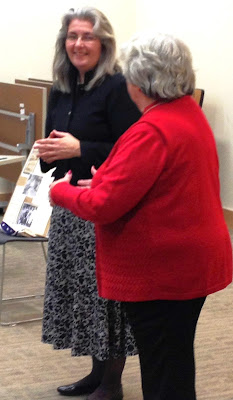New England locations are featured in several middle grade and young adult novels published during World War II. My latest book, Children's Wartime Adventure Novels - The Silent Generation's Vicarious Experience of World War II explores these stories and how they inspired and indoctrinated a young generation too young to fight, but not too young to be affected by a global war. Last week, I posted on locations in western Massachusetts -- Smith College and Mount Holyoke College -- that were settings for two books for girls on officers' training in the WAVES and Women Marines.
Today we explore two young adult novels that show us New London, Connecticut, locations, including the Naval Submarine Base, where young men train during World War II.
Rig
For Depth Charges! by Captain Edward
E. Hazlett begins with the Japanese attack on Pearl Harbor, with a vivid
account in a book that is more realistic than other books for boys in this era. Like the novels Lady Leatherneck by
First Lieutenant Barbara A. White, MCWR and By Your Leave, Sir by
Lieutenant Helen Hull Jacobs, USNR discussed here previously, Rig For Depth
Charges!, a story about submarine warfare, is also penned by someone with
experience in the field. Captain Hazlett’s novel is an engrossing story, not
just the documentation of the training and adventure of a young submariner, but
a well-told tale about the early days of the United States’ involvement in the
war and young man’s realistic experiences at home and abroad.
Capt.
Hazlett served in the Navy in World War I and entered the submarine service in
the 1920s. More than sixteen years of
his thirty years of active duty were spent in the Silent Service.
Some of his most important writing, however,
might be considered to be his longtime correspondence with his boyhood pal,
Dwight D. Eisenhower. He and Eisenhower grew up in Abilene, Kansas, attended high school together,
and both studied to enter military academies as a way to obtain a college
degree when their parents were too poor to send them to civilian colleges. Turns of fate brought Hazlett to the Naval
Academy and Eisenhower to West Point.
Hazlett
is mentioned in Ike’s memoirs, and their correspondence over the years was an
outlet for President Eisenhower to reveal his thoughts on many national and
international issues. Capt. Hazlett died
in 1958 and President Eisenhower attended his funeral and internment at
Arlington National Cemetery. Hazlett’s
widow later donated Capt. Hazlett’s papers, including the correspondence with
Ike, to the Dwight D. Eisenhower presidential library in Abilene, Kansas. They are referenced in Ike’s Letters to a
Friend 1941-1958.

Hazlett's story for boys follows young Robert "Saint" Rodney, a new naval officer who, after experiencing the horror of the Pearl Harbor attack, decides to enter the submarine service, and heads for New London, Connecticut. He and his classmates will spend long hours at their books, with periods of practical work in the
operation of subs in Long Island Sound.
In their free time, they look forward to dates with coeds at nearby
(real-life) Connecticut College for Women (now co-educational Connecticut College), competing with Coast Guard cadets at
the Coast Guard Academy. Joan Underwood,
a journalism student, catches his eye and will become his newest girlfriend.
The colonial coastal town of New London is described, including the Hotel
Mohican, one of the finest hotels in Connecticut at the time, where they enjoy meals in the restaurant, and the “sleepy
little village” of Groton, and sometimes hike to Norwich.

The Hotel Mohican, built in on State Street in New London in 1896, was originally a publishing house for a magazine, but was converted to a hotel two years later. It was one of the grandest hotels in the state. In the 1990s, the building was converted again into apartments.Their
first tour of a sub is described and the young readers get a wealth of detail
in its appearance and manner of operation.
“The party moved on into the incessant din of the engine room. The ship had taken on a gentle heave,
indicating that she had now passed out of the river and into the glassy swells
sweeping in from the Atlantic. An odor
of combined exhaust fumes, bilge water and fuel oil assailed the nostrils.” They learn of water-tight hatches and valves,
and the real-life Squalus disaster in 1939 is recalled when twenty-six
of its crew drowned instantly when induction values failed. (The rest of the crew, thirty-three, were
rescued from the trapped sub in a mission headed by Lt. Commander Charles
Momsen, for whom the Momsen lung was named).

They are introduced to the escape tank on base, a large silo that will be
flooded with water, and in which they will learn to use the Momsen lung and
avoid getting the “bends” under full pressure.
We will also see March Anson in March Anson and Scoot Bailey of the
U.S. Navy have his turn struggling with the lessons in the tank, where some
young officer students panic and some show their mettle.
March
Anson and Scoot Bailey of the U. S. Navy
by Gregory Duncan, is the story of two friends who join different branches of the Navy: Scoot becomes a Navy flier, and March heads for training at the sub school.
We
follow March Anson on his train ride to New London, Connecticut. March meets other sailors, a petty officer, a
radioman, and a pharmacist, all going to the sub base. They discuss their enthusiasm for joining
the subs, what they feel is the toughest branch of service. They
are awed by the escape tower on which they will be tested, the huge water tank we
first experienced in Rig for Depth Charges! There is the mundane description of March’s
settling in – officer quarters for unmarried officers – those with wives along
could live in town – and the mess. Standards are high for submarine service as
there are not as many openings. “What
they looked for in the ‘Diving Navy’ was the kind of man who was brave, cool
under fire, far above average intelligence, with the ability to get along well
with other people under all circumstances, and the kind of nerves that didn’t
crack or even show strain under the greatest danger, the worst crowding, or
seeming fatal situations.”
These books for boys written during World War II were a window on a world of adventure and opportunity for the young readers; and for us, a window on a world on fire as it looked to American children whose fathers and older brothers were gone to war.
Next week, I'll post on War Wings for Carol, a book that is set on an airfield in northern Maine that is shared by a small commercial airline and the military. One young woman's home front job supports the U.S. war effort in more ways than one, and descriptions of small-town Maine are delightful.
Children's Wartime Adventure Novels is available in eBook directly from my online store here.
It is also available in eBook from Barnes & Noble, Apple, and a wide variety of online shops here.
It is also available in eBook, paperback, and hardcover from Amazon here.
******************
Jacqueline T. Lynch is the author of The Ames Manufacturing Company of Chicopee, Massachusetts - A Northern Factory Town's Perspective on the Civil War;
Comedy and Tragedy on the Mountain: 70 Years of Summer Theatre on Mt. Tom, Holyoke, Massachusetts;
States of Mind: New England,
A Tragic Toast to Christmas -- The Infamous Wood Alcohol Deaths of 1919 in Chicopee, Mass.; as well as books on classic films and several novels. Her Double V Mysteries series is set in New England in the early 1950s.
TO JOIN HER READERS' GROUP - follow this link for a free book as a thank-you for joining.

























